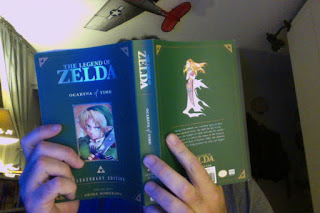Lucas Blogs About The Legend of Zelda: Ocarina of Time
 |
| Oh, so that's what Link was saying. |
What is it this time, Hypothetical Reader?
A kids' book was one thing, but the manga adaptation of a video game? Have you no shame?
You know, even for a rhetorical device intended to give voice to my own anxieties about how others perceive me, you sure can be judgmental.
Okay, okay, I have my guilty pleasures, too.
Guilty pleasures? Who has time for that, enjoy what you enjoy, HR.
Fine. So, what's this book's deal?
You ever play Ocarina of Time on the N64?
Of course.
It's like that.
You're the wors-
JK LOL!!!! So, it has the same basic plot as the game, Link has to leave his home in the Kokiri Forest to meet Princess Zelda and fulfill his destiny as the Hero of Time. There are a few tweaks here and there, but no real surprises. The main difference is that instead of being the strong, silent type he is in the game, Link is quite talkative. This makes him more of an active participant in the plot. Sure he's still doing whatever other people tell him to do, but he has more agency and is invested in his quest and finding his place in the world. In addition to the Child and Adult arcs, this includes a pair of side stories in which kid Link befriends future Majora's Mask antagonist, Skull Kid, and one where adult Link saves the prince of a tribe of bird people.
Hey, I just looked at the labels and you said this book is "only okay." But you seem pretty complimentary. What gives?
The storyline is rushed. Because, they squeeze most of the story beats from the game into the manga (and throw in a new tragic backstory for the dragon, Volvagia, from the Fire Temple), mangaka Akira Himekawa (a psuednonym for two women who individually work under the names A. Honda and S. Nagano (also psuedonyms)) leave themselves little room to develop characters outside of Link and Zelda. Though most of the game's important characters do get a moment in the spotlight.
Fair enough, what did you think of the artwork?
Himekawa's style hews pretty closely to that of your standard shonen manga, with expressive characters and compositions that favor dynamism over rigid panel divisions. This means that pages often look cool, but can sometimes lead to confusion over which order to read dialogue in (this isn't usually a problem, but it can be distracting).
Would you say that's related to the compressed story?
Yes! You'd think that the game's structure, with story revelations spaced between dungeons, would work well in a manga. However, because the dungeons themselves are puzzles they can't be easily translated into comic pages. So Himekawa's story largely eschews them in favor of boss fights that escalate quickly after seeming to spring from nowhere.
So, do you recommend it?
Hmm, well, I definitely enjoyed it. But it was a gift from a friend and I'm not entirely sure that I would have bought it for myself. However, if you collect Zelda paraphernalia, this edition is part of Viz Media's Legendary Edition of Himekawa's Zelda comics, and would look very nice on your shelf.
That's still a little wishy-washy, Lucas.
¯\_(ツ)_/¯
The Legend of Zelda: Ocarina of Time story and art by Akira Himekawa, Viz Media paperback edition, December 2016, 378 pages, pairs well with Lon-Lon milk
Links (get it?):
Akira Himekawa's website (Unsurprisingly, it's in Japanese).
Viz media's other Zelda manga translations.
Arguably, this manga's greatest weakness is it's lack of the Gerudo Valley theme.
Comments
Post a Comment